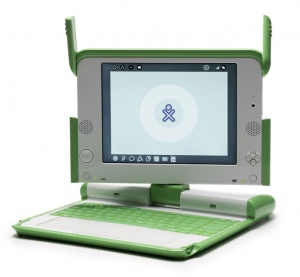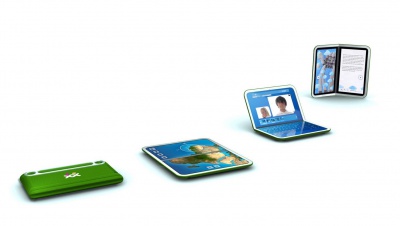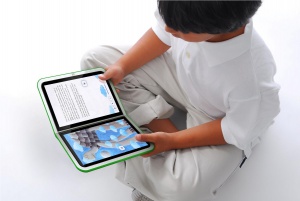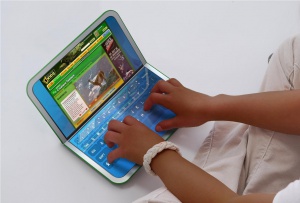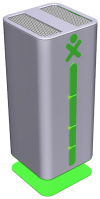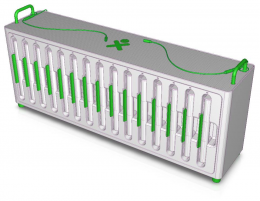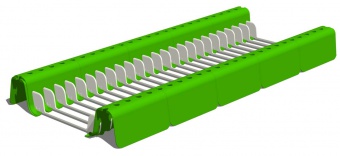Hardware
One Laptop Per Child believes that innovative design is capable of bringing robust computing to children in the developing world at low power and low cost. This began with the XO laptop, and continues with the second generation handbook and peripherals.
XO Laptop
The XO Laptop is the most rugged low power, low cost laptop currently available.
- The Children's Laptop
- Why it is unique
- Details of the Laptop Hardware
- The definitive laptop specification (only available in PDF format).
- Keyboard
- Display
- Batteries (Battery Charging)
- Certifications (Safety and RF emissions)
- Environmental Impact (The Green Machine)
- User modifications of the laptop
Versions: production: C2; pre-production: C1, B4, B3, B2, B1, A1
While developing the XO, many ideas for hardware were contributed.
2
In May of 2008, plans for the next generation of OLPC laptops were publicly announced. The design goals relative to the first generation XO are (in order):
- Lower Power
- Lower Cost
- More Robust
- Higher Performance
Nicholas Negroponte challenged the design team to aim for those goals while also rethinking the notion of a laptop. The second generation educational device from OLPC doesn't fit neatly into the "laptop" category. The form factor is that of a book or folded (clam shell) tablet --- we prefer to call it a handbook. The entire interior surface is a multi-touch sensitive display. Each individual display will have a 16:9 aspect ratio.
The handbook will be sealed against dust intrusion and anything up to, but not including, immersion in water. The case material will flex to cover the hinge section between the pieces, allowing a single piece outer shell and greatly simplifying the sealing. The bezel between the displays will be minimized around the hinge. The handbook will open flat (and lie flat), providing a roughly square display suitable for writing, exploring graphical material or "board" games. Both screens will be driven with the same, or identical, graphics and video processors.
While the displays are identical, the industrial design will be biased, with one side of the handbook being heavier to provide stability when used in laptop mode. In this mode, manual input devices are synthesized on the lower display, resting flat on a surface. This display may also be equipped with tactile feedback devices to enhance the "typing" experience. One advantage of such a programmable input surface is that keyboards may be changed from one set of glyphs to another instantly. Likewise, alternative keyboards such as piano may be provided.
XS School Server
While the laptop is rightfully at the center of OLPC, a valuable peripheral is the school server. Recognizing this, OLPC designed a School server to extend the storage and computation provided by each laptop, as well as providing a local library and a mesh portal to the Internet. But this is more of a collection of services than a hardware platform. Unlike the laptop, which has a well defined user load (one child), the school server is designed to serve an entire school, whose sizes vary greatly. Thus a variety of hardware solutions is necessary. Thankfully, an entire industry is available serving this hardware need, at a variety of price and power levels from small fanless systems to desktop PCs to large servers. For example, small and mid-sized schools should be well served by this recommended hardware.
There is a persistent need for a low cost, robust server solution for environmentally extreme and low power situations (jungles/salt water). OLPC designed a low cost XS server (pictured) with sealed operation up to 50C. Unfortunately, it is still looking for a manufacturer.
Peripherals
In addition to the laptops and handbooks, there are some peripheral hardware components in whose design OLPC is involved.
Multichannel battery charger
Classroom situations, especially those without "grid" power, are challenging for powering laptops. One of the solutions is a multiple battery charger, which allows a number of laptop batteries to be charged in a small cabinet taking AC or 12VDC input.
OLPC has pursued the design of a Multi-Battery Charger for the XO Laptop, and has units entering safety testing in Jan. 2008.
XO Rack
When laptops are not in use, or require charging it can be difficult to safely and practically store them. For this purpose a low cost rack system has been developed. The Rack easily assembles and disassembles – requiring no tools and can be screwed down for additional robustness.
The XO Rack is now available for purchase. For more information, please see Product News page.
Active Antenna
The Active Antenna is the same Marvell radio used in the XO laptops, but on a 5m USB cable allowing their use either standalone (with a power supply) or with a School server. Unfortunately, Active Antenna production is awaiting the development of a better mesh implementation for dense mesh situations. We currently recommend the use of traditional 802.11b/g access points with the XO.
